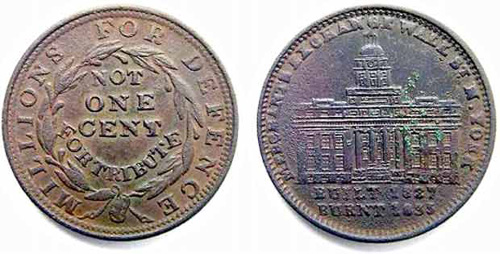
| < Prev. | ⇑ | Next > |

Merchants Exchange Token--The phrase "Millions for defence, but not one cent for tribute," is carried on many pieces. Charles Cotesworth Pinckey of South Carolina, U.S. minister to France in 1796, made that sententious remark in response to French Directory's hope to force the US to side with France against England in the war that could be averted by the payment of large bribes to certain officials.
The cry was taken up again at the outbreak of the War against the Barbary Pirates, previous to which the US Government, in its days of weakness, had paid an annual tribute, as did most of the European powers, to the semi-barbarous rulers of North Africa. The young Republic threw off the Barbary yoke by settling the tribute forever with the American frigates' guns at Tripoli.
The NOT ONE CENT of the Pinckney cry was still a phrase to conjure with when placed on these tokens, where it served as a protection for the coppers issued during the suspension of specie (coin) payments in Van Buren's new administration, to declare their character as a nonlegal coinage.
The merchant tokens were status symbols for the wealthy merchant class in a very inegalitarian America. New York City's wealthy families of the Hard Times period were concentrated in the southern tip of Manhattan. A supposedly fireproof Merchants Exchange building was erected in 1827 on Wall Street, but it was destroyed in the Great Fire of 1835.
Privacy Policy || Cookies Policy